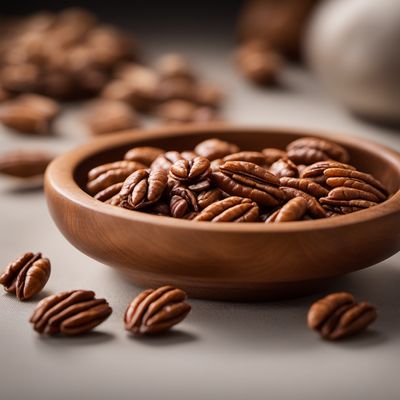
Ingredient
Pecans and similar-
Nutty Delights
Pecans and similar nuts are characterized by their smooth, buttery texture and rich, nutty flavor. They have a distinct oval shape with a light brown outer shell and a cream-colored kernel inside. These nuts are commonly used in both sweet and savory recipes, adding a delightful crunch and enhancing the overall taste of the dish.
Origins and history
Pecans and similar nuts have a long history dating back to ancient times. Native to North America, they were an important food source for Native American tribes. Pecans were introduced to Europe in the 16th century and gained popularity as a culinary ingredient. Today, they are widely cultivated in the southern United States and are enjoyed worldwide for their delicious taste and nutritional benefits.
Nutritional information
Pecans and similar nuts are a good source of healthy fats, protein, and fiber. They also contain essential minerals such as manganese, copper, and zinc. However, they are calorie-dense, so portion control is important when incorporating them into your diet.
Allergens
Pecans and similar nuts may cause allergic reactions in individuals with nut allergies. It is important to be cautious and avoid consumption if you have a known allergy.
How to select
When selecting pecans and similar nuts, look for ones that are plump, with a smooth and unblemished shell. Avoid nuts that have a rancid or bitter smell, as this indicates they may be spoiled. Additionally, choose nuts that feel heavy for their size, as this indicates freshness.
Storage recommendations
To maintain the freshness and quality of pecans and similar nuts, store them in an airtight container in a cool, dry place. Alternatively, you can refrigerate them to extend their shelf life. Avoid exposing them to moisture or heat, as this can cause them to spoil or become rancid.
How to produce
Pecans and similar nuts can be grown in suitable climates by planting the nuts in well-draining soil and providing adequate sunlight and water. However, they require a long growing season and are best suited for regions with mild winters and hot summers.
Preparation tips
Pecans and similar nuts can be enjoyed in various ways. They can be eaten raw as a snack, roasted and seasoned for added flavor, or used as a topping for salads, desserts, and baked goods. They are also commonly used in the preparation of pecan pies and other nut-based desserts.
Substitutions
Almonds, walnuts, and cashews can be used as substitutes for pecans and similar nuts in recipes. They offer a similar nutty flavor and texture, although the taste may vary slightly.
Culinary uses
Pecans and similar nuts are widely used in both sweet and savory dishes. They are commonly incorporated into baked goods such as cookies, cakes, and bread. They also pair well with salads, roasted vegetables, and meat dishes, adding a delightful crunch and nutty flavor.
Availability
Pecans and similar nuts are commonly available in the United States, particularly in the southern states where they are grown. They are also cultivated in other countries such as Mexico and Brazil.

